|
|
|
Any change that will make the FireFly fly quieter and faster is worth doing. I have an IVO that is a candidate for modification, so I took some measurements and drew up some templates that could be used. The red and green lines represent the original propeller shape. The black lines represent the modified shape and/or profile. (Note: the airfoil profiles have been exaggerated.) The angle shown between the old tip end line (green) and the new end profile (black) is 35 degrees. (Note: Terry set this angle at 20 degrees. A Google search revealed that this angle can be 20 to 35 degrees.) The radius of the curve that connects the new end profile to the to the leading edge is .5 inches. The tip is shown with a sharp point. I will slide the profile out another quarter of an inch so there will be a small flat profile remaining on the tip.
I have added this to my short list of things to do. I will post a follow up.
|
|
Power tips give a much quieter propeller. On down wind cruise and with the engine turning 5,200 rpm, the sound meter read 106 db. This is five db less than what had been recorded earlier for the 56 inch prop. The bad/good news is that I cannot verify Terry's increase in speed, but the tip has improved performance in a positive way. I took an out and back trip from K02. I flew upwind for a gps distance of 27 miles and then reversed course and flew back to the airport. A cold front had come through and so the EGT was running 50 degrees higher, and so one would expect better engine performance but also a higher air density should increase drag too.
Comparing this data to the previous 94 mile 90+ degree round trip data, I gained l.2 mph with the addition of the power tips. Fuel flows were the same at 2.20 gph, but the power tips added a little range going from 22.1 to 22.7 mpg.
|
|
1. To start one needs a half sheet of printer paper. The best way to get it is to fold it over on its self, match a corner, flatten the paper, crease it and then open it and tear the paper through the middle of the sheet (green line). 2. Fold the paper again in the opposite direction placing cut corner to cut corner. Press the paper flat and form the crease. Do not tear at the folded crease (red line from 1 to 2).
|
 3. Lay the paper so that the cut edge (line 2 to 3) lies on the back side of the propeller blade with the edge even with the cut edge of the blade tip and the crease (line 1 to 2) even with the leading edge.
3. Lay the paper so that the cut edge (line 2 to 3) lies on the back side of the propeller blade with the edge even with the cut edge of the blade tip and the crease (line 1 to 2) even with the leading edge.
4. Mark the trailing blade edge line (line 3 to 4) and cut the excess paper away. |
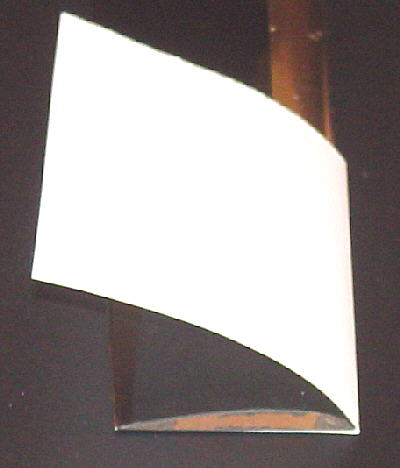 5. Slip the template back into position as described in #3, fold the paper back over the blade top surface, and mark the paper at the blade trailing edge (line 6 to 7). Again cut away the excess paper.
5. Slip the template back into position as described in #3, fold the paper back over the blade top surface, and mark the paper at the blade trailing edge (line 6 to 7). Again cut away the excess paper.
|
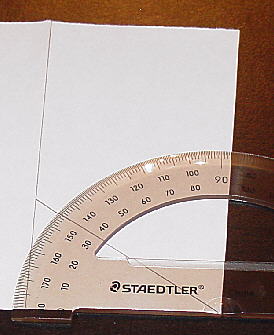 6. Using a protractor with the center located at the corner (point 3) and the zero angle line to the right and covering the cut edge, scribe a mark at the 35 degree position. Then draw in the new tip cut line from 3 to 5.
6. Using a protractor with the center located at the corner (point 3) and the zero angle line to the right and covering the cut edge, scribe a mark at the 35 degree position. Then draw in the new tip cut line from 3 to 5.
|
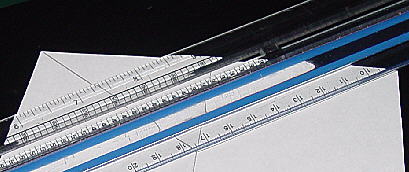 7. Place the template open and flat and draw a line from the crease (red line) to the trailing corner to form the upper surface edge cut (line 5 to 6).
7. Place the template open and flat and draw a line from the crease (red line) to the trailing corner to form the upper surface edge cut (line 5 to 6).
|
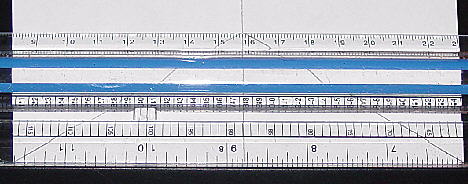 8. Draw line parallel to blade tip (line 3 to 2 to 6) and through point 5.
8. Draw line parallel to blade tip (line 3 to 2 to 6) and through point 5.
|
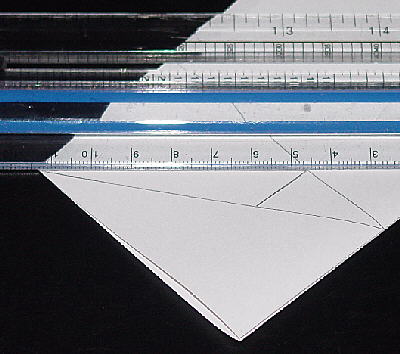 9. Replace the template over the blade tip holding it on each side at the trailing edge. Using your finger nail carefully crease the paper over the trailing edge of the blade leading edge protective armor. Remove the template, place it flat on the table and draw a line parallel to the crease (red line) over the impression of the front blade protector (line 8 to 9). And finally, draw line from point 8 to point 6.
9. Replace the template over the blade tip holding it on each side at the trailing edge. Using your finger nail carefully crease the paper over the trailing edge of the blade leading edge protective armor. Remove the template, place it flat on the table and draw a line parallel to the crease (red line) over the impression of the front blade protector (line 8 to 9). And finally, draw line from point 8 to point 6.
|
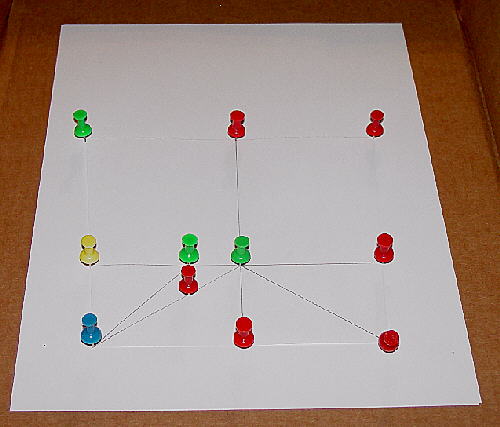 Using the master template, one must make two or three identical templates to be used in shaping the individual propeller blades. This is done by laying the master template on top of two or three sheets of printer paper and using straight pins to drive holes through at each line intersection that was marked with a number. Then all holes are interconnected with lines by using a fine line pen/pencil and a straight edge. The excess paper is trimmed away. Each template is carefully folded along line 1 - 5 - 2.
Using the master template, one must make two or three identical templates to be used in shaping the individual propeller blades. This is done by laying the master template on top of two or three sheets of printer paper and using straight pins to drive holes through at each line intersection that was marked with a number. Then all holes are interconnected with lines by using a fine line pen/pencil and a straight edge. The excess paper is trimmed away. Each template is carefully folded along line 1 - 5 - 2.
Number each blade on the butt end, and using a digital postal scale record each blade weight.
|
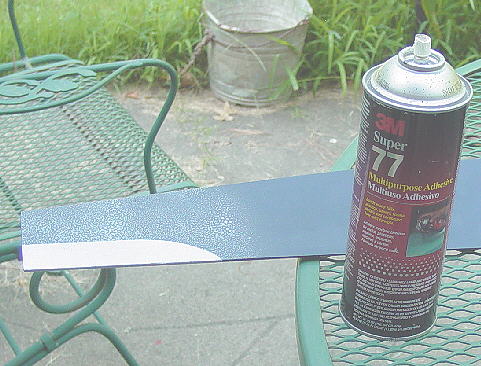 The outer end of the propeller is sprayed front and back with adhesive, and the template is wall papered onto the blade starting on the back side at the trailing edge and the outer corner. Then one smoothes and rolls the paper up over the leading edge and back over to the front trailing edge.
The outer end of the propeller is sprayed front and back with adhesive, and the template is wall papered onto the blade starting on the back side at the trailing edge and the outer corner. Then one smoothes and rolls the paper up over the leading edge and back over to the front trailing edge.
|
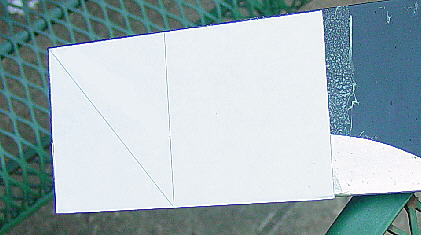 The blade is clamped or held down with the flat side up, and using a hacksaw with a very fine tooth blade, the tip is cut away along line 3 to 5. Start the cut at the trailing edge with light pressure and carefully saw along or split the line toward the front.
The blade is clamped or held down with the flat side up, and using a hacksaw with a very fine tooth blade, the tip is cut away along line 3 to 5. Start the cut at the trailing edge with light pressure and carefully saw along or split the line toward the front.
|
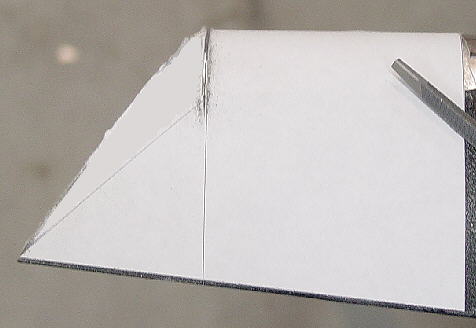 Flip the blade over and re clamp. Using a small triangular file, file the line 5 to 8. This cuts through the protective leading edge armor. Take care doing this so that you do not remove any actual blade material. File from the back toward the front of the blade. When one files through the material one can see the black blade material below.
Flip the blade over and re clamp. Using a small triangular file, file the line 5 to 8. This cuts through the protective leading edge armor. Take care doing this so that you do not remove any actual blade material. File from the back toward the front of the blade. When one files through the material one can see the black blade material below.
Using a razor blade score the paper along line 8 to 6, and then peal off the protective leading edge armor material and the pattern enclosed by points 5, 8, & 6. This exposes the area that must be rounded into an airfoil shape. |
 Starting with a coarse flat file, round from the upper edges of lines 5 to 8 and 8 to 6 down to the line 3 to 5 on the back side of the blade. When you are close to the final shape switch to a fine flat file to achieve a smoother surface. Roll the file as it passes over the surface and change your direction with each pass. If you do, one can generate a very smooth continuous surface.
Starting with a coarse flat file, round from the upper edges of lines 5 to 8 and 8 to 6 down to the line 3 to 5 on the back side of the blade. When you are close to the final shape switch to a fine flat file to achieve a smoother surface. Roll the file as it passes over the surface and change your direction with each pass. If you do, one can generate a very smooth continuous surface.
After all blades have been cut, weigh them again to see that they maintain the same weight differences as were previously recorded. By this method they should weight within 5 grams of each other. If not take a little more material off the heaviest blade at the tip until that blade comes into its original weight difference or less. |
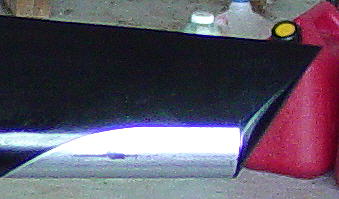 At this point I sprayed some black paint onto the tips, remounted the propeller for a test flight.
At this point I sprayed some black paint onto the tips, remounted the propeller for a test flight.
In the near future, I will be looking at armoring the exposed tips. A word of caution, one should wear breathing protection when cutting and shaping blade tips. Also, please remember that if you are cutting a left rotating propeller tip as a opposed to a right rotating propeller tip, the templates will be mirror images of each other.
|
 Terry, from the Kolb-List and FireFly owner, modified a Tennessee 66 inch wood propeller for quieter operation, and in addition gained some cruise speed (4 mphi). His modification modeled a Top Flight Propeller Power Point Tip.
Terry, from the Kolb-List and FireFly owner, modified a Tennessee 66 inch wood propeller for quieter operation, and in addition gained some cruise speed (4 mphi). His modification modeled a Top Flight Propeller Power Point Tip.
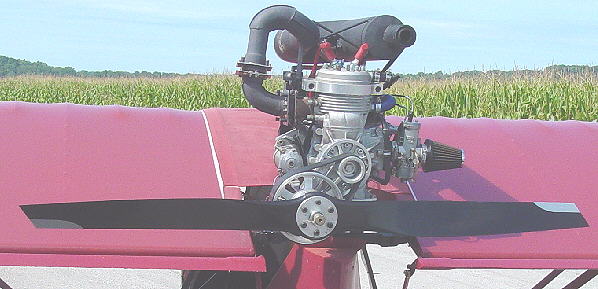
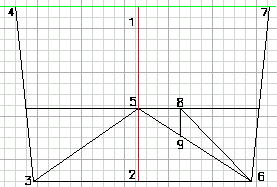 I used cad/cam to lay out a template, but I am going to describe how make a master template without the aid of cad/cam.
I used cad/cam to lay out a template, but I am going to describe how make a master template without the aid of cad/cam.